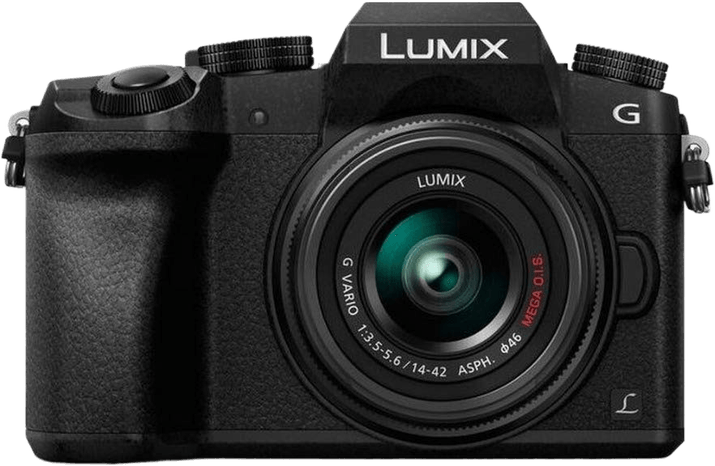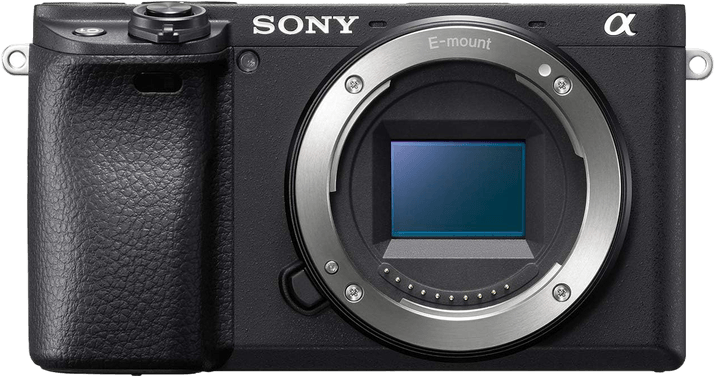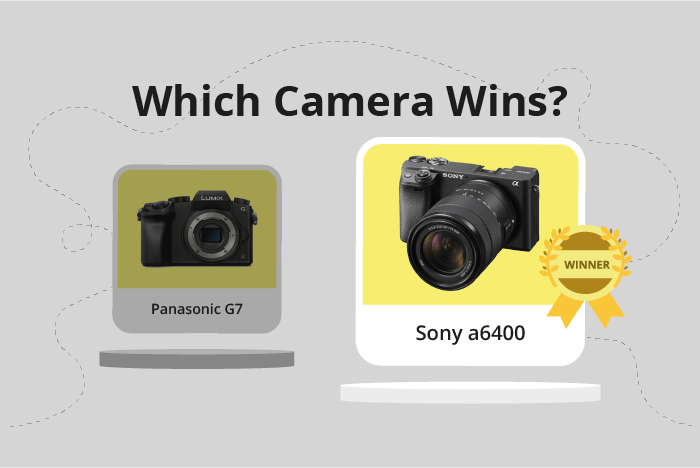Panasonic Lumix DMC-G7 vs Sony a6400 Comparison
Panasonic Lumix DMC-G7

Sony a6400

The Sony a6400 takes the lead with a score of 70/100, outperforming the Panasonic Lumix DMC-G7, which scores 52/100. Both mirrorless cameras share similarities in their launch prices, with the G7 at $799 and the a6400 at $900. They also have comparable weights, with the G7 weighing 410g and the a6400 at 403g.
The a6400 surpasses the G7 due to its more recent release in 2019, providing updated technology and features. Additionally, the a6400 has a more compact size, measuring 120x67x60mm compared to the G7’s 125x86x77mm.
On the other hand, the Panasonic G7, released in 2015, still offers respectable performance despite its lower score. Its advantage lies in its slightly lower launch price, making it a more affordable option.
Comparing the two, the Sony a6400 stands out as the better camera, offering updated technology and a more compact design. However, the Panasonic G7 remains a viable choice for those seeking a more budget-friendly option.
Panasonic Lumix DMC-G7 vs Sony a6400 Overview and Optics
The Sony a6400 outperforms the Panasonic Lumix DMC-G7 in optics, scoring 68/100 compared to the G7’s 51/100. Both cameras share some specifications, such as a CMOS sensor, no image stabilisation, and the same aspect ratios of 3:2 and 4:3 respectively.
The Sony a6400 excels with its higher megapixel count of 24.2, allowing for more detailed images, compared to the G7’s 16 megapixels. Additionally, the a6400’s shooting speed of 11 frames per second (fps) surpasses the G7’s 7 fps, making it better suited for capturing fast-moving subjects. The a6400 also boasts a superior DXOMARK sensor score of 83 and an APS-C sensor size, while the G7 has a score of 75 and a smaller Micro Four Thirds sensor. Furthermore, the a6400 features a Bionz X processor, contributing to better image quality and processing speed.
On the other hand, the Panasonic Lumix DMC-G7 has a Micro 4/3 lens mount, which offers a wider selection of lenses compared to the Sony E mount. This could be advantageous for photographers seeking a specific lens type or wanting to experiment with different lenses.
Taking these factors into account, the Sony a6400 emerges as the better option for those prioritizing image quality, speed, and performance. However, the Panasonic Lumix DMC-G7 may still appeal to photographers who value lens versatility and a broader lens selection.
Panasonic Lumix DMC-G7 vs Sony a6400 Video Performance
The Sony a6400 emerges as the winner in the video capabilities comparison, boasting a video score of 91 compared to the Panasonic Lumix DMC-G7’s score of 83. Both cameras share some common specifications in this regard, such as 4K video resolution and dimensions of 3840 x 2160. Additionally, they both have built-in time-lapse functionality, making them suitable for capturing dynamic scenes.
The Sony a6400 outperforms the Panasonic G7 in terms of video frame rate, offering a remarkable 120 frames per second (fps) as opposed to the G7’s 60fps. This higher frame rate allows the a6400 to capture smoother and more detailed slow-motion footage, making it an ideal choice for videographers who require this feature for their projects.
On the other hand, the Panasonic G7 still holds its ground with a respectable video score of 83. While it may not offer the same level of frame rate as the Sony a6400, its 60fps capability is sufficient for most casual users and even some professional applications. This shows that the G7 is not entirely outclassed in the video department and remains a viable option for those with different priorities or budget constraints.
Taking these factors into account, the Sony a6400 proves to be the superior choice for video capabilities due to its higher video score and impressive 120fps frame rate. However, the Panasonic G7 remains a competent contender, offering solid video performance that may be adequate for the needs of many users. Ultimately, the decision will depend on the specific requirements and preferences of the individual photographer or videographer.
Panasonic Lumix DMC-G7 vs Sony a6400 Features and Benefits
The Sony a6400 emerges as the winner with a feature score of 81/100, compared to the Panasonic Lumix DMC-G7’s score of 58/100. Both cameras share several common specifications, such as a 3-inch screen size, touchscreen capabilities, flip screens, and the absence of GPS. They also both offer WIFI connectivity.
The Sony a6400 excels in a few areas, giving it the higher feature score. The most significant advantage is the screen resolution, with 921,600 dots, providing a clearer and sharper display than the Lumix G7’s 2,360,000 dots. Additionally, the a6400 includes Bluetooth connectivity, which the G7 lacks. This feature allows for seamless pairing with other devices and easier file sharing.
In contrast, the Lumix G7 has a few advantages over the Sony a6400, despite its lower feature score. The G7’s screen resolution is higher, which may lead to better image preview and review capabilities. However, this difference may not be significant enough for most users to notice.
Considering the feature scores and shared specifications, the Sony a6400 is the superior camera. Its higher screen resolution and Bluetooth connectivity set it apart from the Lumix G7. However, the G7’s higher screen resolution should not be entirely dismissed, as it may benefit some users. Ultimately, the choice between these cameras will depend on individual preferences and priorities.
Panasonic Lumix DMC-G7 vs Sony a6400 Storage and Battery
The Sony a6400 wins in the storage and battery category with a score of 37/100, while the Panasonic Lumix DMC-G7 scores 35/100. Both cameras have one memory card slot and accept SD, SDHC, and SDXC cards. Additionally, both offer USB charging capability.
The a6400 outperforms the G7 in battery life, providing 410 shots compared to the G7’s 350 shots. This longer battery life is beneficial for extended shooting sessions. The a6400 also has the advantage of accepting Memory Stick Duo cards, which adds versatility to its storage options.
On the other hand, the G7 does not have any significant advantages over the a6400 in the storage and battery category. Both cameras have similar storage capabilities, and the G7’s battery life is shorter than the a6400’s.
Considering the longer battery life and additional storage compatibility, the Sony a6400 is the better choice in terms of storage and battery capabilities. The Panasonic Lumix DMC-G7, while not far behind, falls short in this comparison.
Panasonic Lumix DMC-G7 vs Sony a6400 – Our Verdict
Are you still undecided about which camera is right for you? Have a look at these popular comparisons that feature the Panasonic Lumix DMC-G7 or the Sony a6400:

